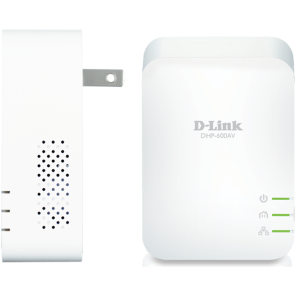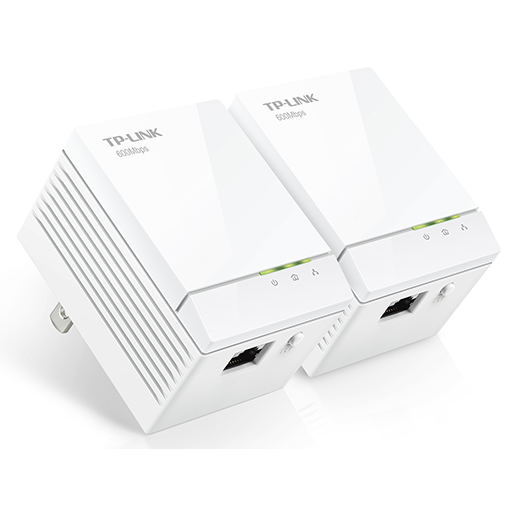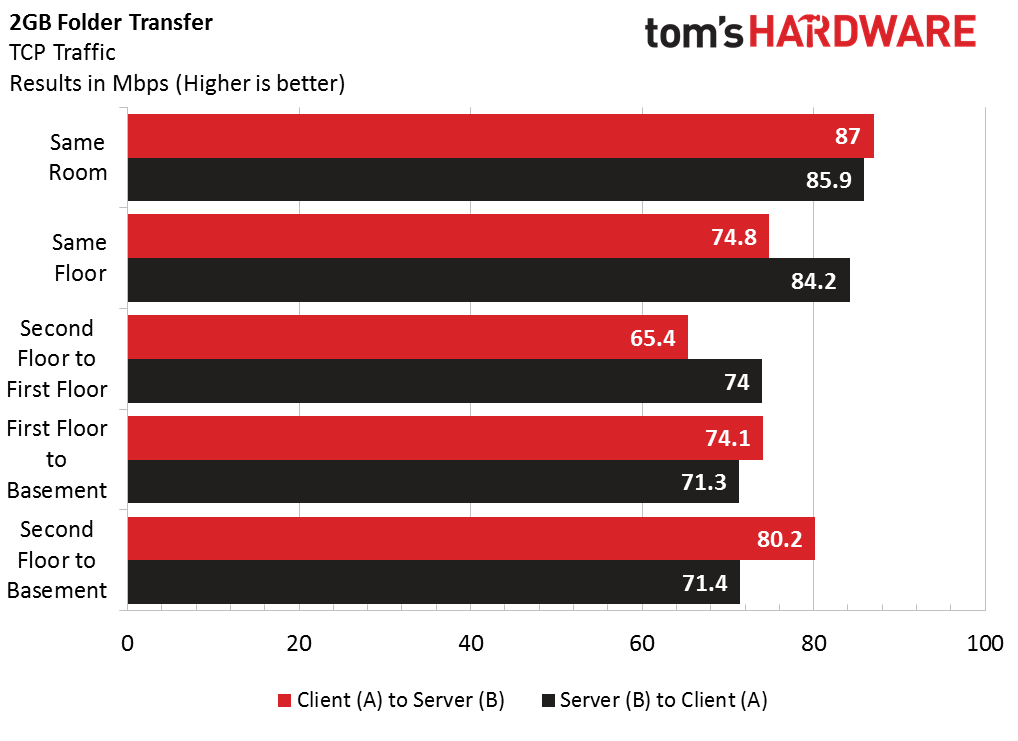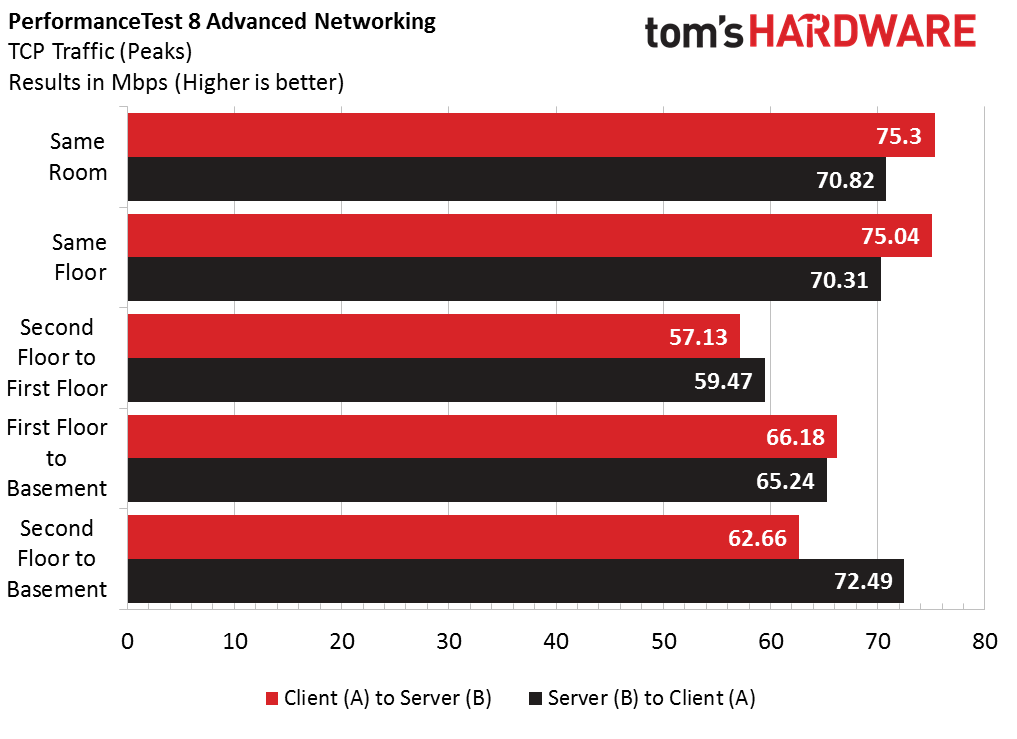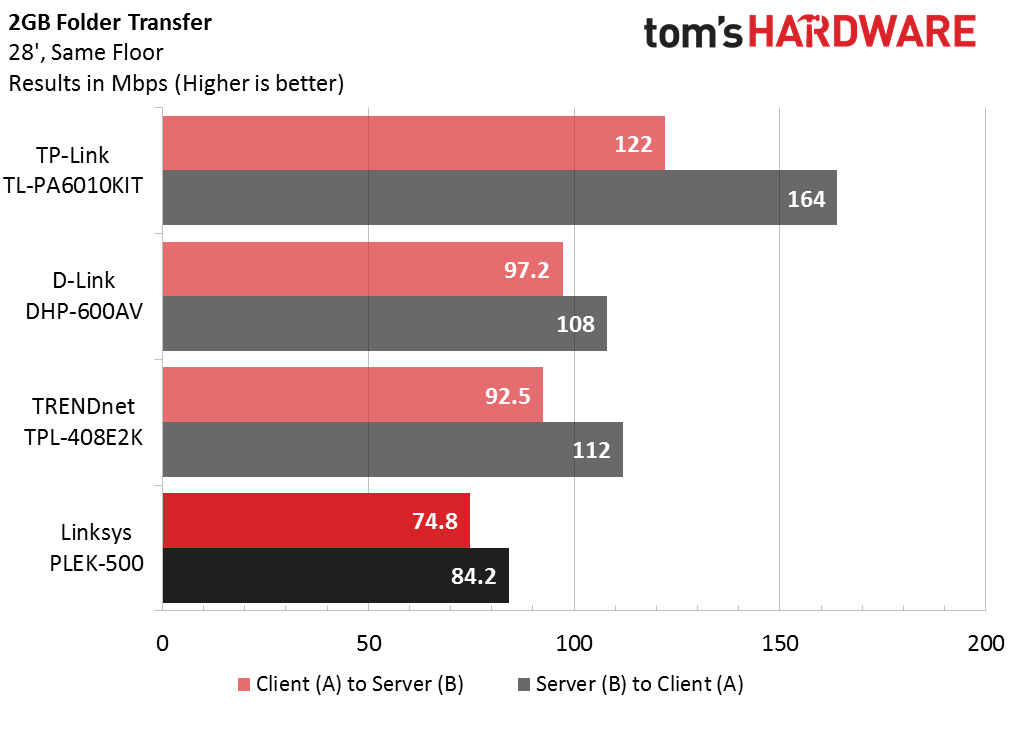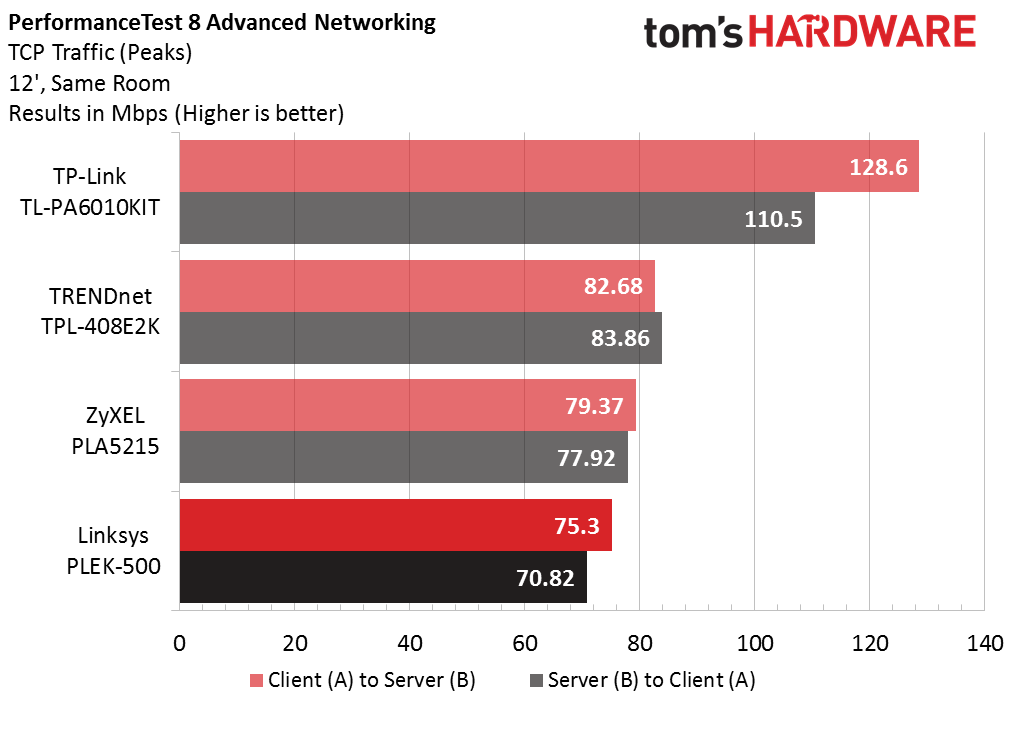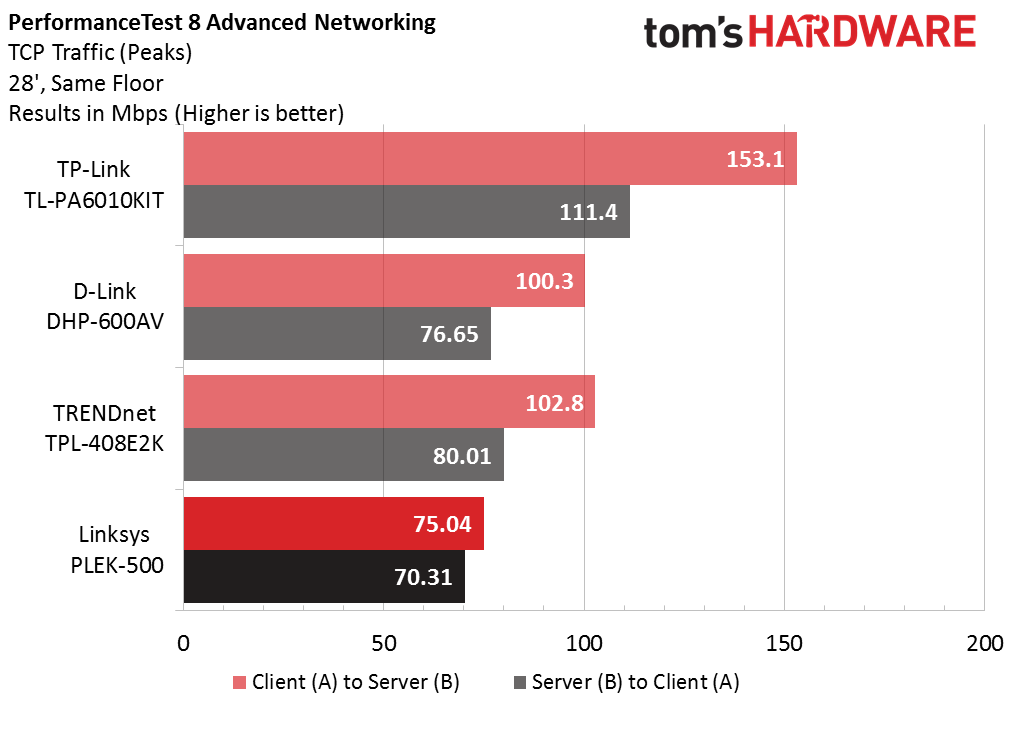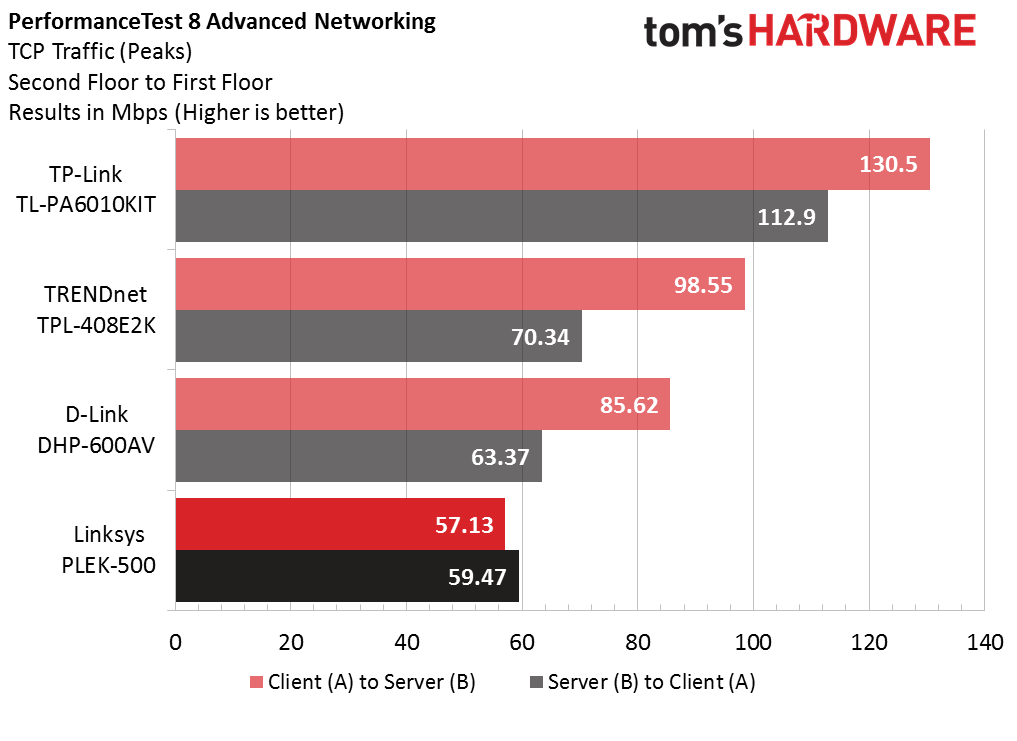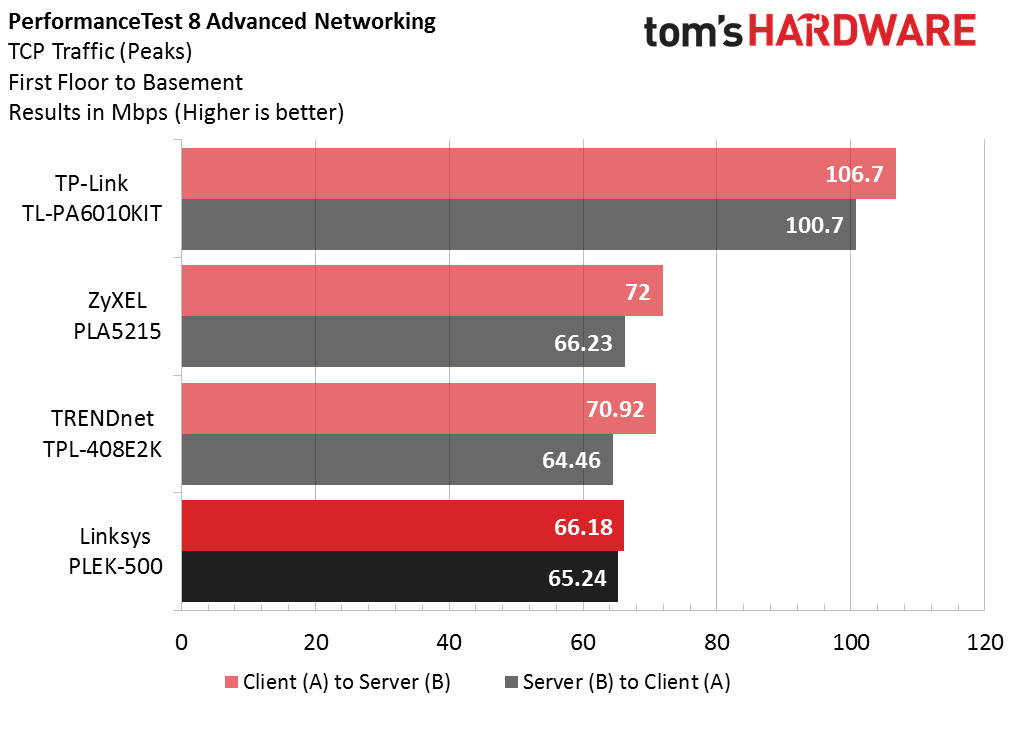Linksys PLEK-500 Powerline Networking Adapter Review
For those looking to expand their home networks without having to run additional cabling, or dealing with weak Wi-Fi coverage, Tom's Hardware looks at Linksys PLEK-500 Powerline Kit.
Why you can trust Tom's Hardware
Test Results And Conclusion
Comparison Powerline Networking Adapters
Solo Round
We tested the Linksys PLEK-500 using the system configurations and procedures outlined in our How We Test article. Here's how the Linksys PLEK-500 performs:
According to traditional thoughts of signal degradation, the two gigabyte folder results follow the logic that the farther away the Powerline adapters are, the worse they perform. We then switched from testing a simple file copy via file shares to benchmarking throughput using Passmark's PerformanceTest 8 utility.
When using the PerformanceTest software, results were best the closer the Powerline adapters were to each other. While the graph above shows the absolute peak value observed through the testing period of three minutes, the graph below shows that the average throughput stayed relatively close to peak values.
In The Mix
Now let's compare how well Linksys stands up to the top three performers in our Powerline adapter round-up. First, the 2GB folder transfer:
Measured against the top three performers of our recent round-up in the Same Room test, the Linksys PLEK-500 falls just below ZyXEL's PLA5215 in aggregate numbers.
Linksys again appears under the top three when extending the length of the test from two outlets in the same room to two outlets on the same floor.
For the next test, I placed an adapter on the second floor, keeping the other on the first floor.
Get Tom's Hardware's best news and in-depth reviews, straight to your inbox.
Linksys trails behind the top three yet again, and the trend continues in the next test of the first floor to the basement.
Saving the best for last, Linksys pulls ahead into the bronze position in the second floor to basement test.
Next, we switch our testing software over to PassMark's PerformanceTest8 and repeat the tests from the same positions to see how Linksys' PLEK-500 compares to the top three in each test from our prior round-up.
While not too far behind third place, Linksys' PLEK-500 finishes below our top three performers in the same room test.
In the same floor test, however, Linksys falls further behind the top three.
When testing from the second floor to the first floor, Linksys not only performs below the top three, but overall ends up the worst performance I observed in any test, even comparing Linksys' own numbers. Not sure what happened there.
In testing performance from the first floor to the basement, Linksys again falls short of breaking into the top three.
As if it had something to prove at this point, Linksys' PLEK-500 adapters edge their way into third place in the final test.
All of these tests show the peak values observed, but the averages yield the same finishing order. In short, Linksys takes a lower spot than the top three performers. Also, in the UDP tests, Linksys' PLEK-500 adapters completely flooded the switch I was using, invalidating the results of any UDP tests. Basically, there was too much packet loss.
Conclusion
Newegg lists the Linksys PLEK-500 kit for $100, and although it was one of the lower-performing Powerline adapters in our testing, its throughput remained above 55 Mb/s in every benchmark. Also, having the ability to upgrade the firmware through Linksys' advanced configuration utility might be a good thing if a future upgrade increases performance.
Overall, the PLEK-500 is a solid set of Powerline adapters worth considering if you can get them for less than competing devices, which are typically faster.
MORE: Powerline Networking 101
MORE: How We Test Powerline Adapters
MORE: All Powerline Content
MORE: All Networking Content
Matthew Matchen is an Associate Contributing Writer for Tom's Hardware. Follow him on Twitter @matchemm
Follow us on Twitter @tomshardware, on Facebook and on Google+.
-
Flying-Q What is the topology of the test environment? Specifically, do any of the floors' power circuits communicate via a consumer unit? Having installed several varieties of Powerline adaptors over recent years in the UK, I have found that TP-Link products are able to connect through a consumer unit when for example upstairs and downstairs have separate ring circuits off breakers in the same consumer unit. Devolo products also are able to do this. There is a degradation in throughput in this scenario, but still gives better results than wifi over the same range.Reply -
getochkn ReplyWhat is the topology of the test environment? Specifically, do any of the floors' power circuits communicate via a consumer unit? Having installed several varieties of Powerline adaptors over recent years in the UK, I have found that TP-Link products are able to connect through a consumer unit when for example upstairs and downstairs have separate ring circuits off breakers in the same consumer unit. Devolo products also are able to do this. There is a degradation in throughput in this scenario, but still gives better results than wifi over the same range.
They tell you how, there is even a link at the end of the article.
http://www.tomshardware.com/reviews/how-we-test-powerline-networking-adapters,4217.html
How we test powerline adapters. -
Flying-Q Reply
I had already read that article and it does not address my question. Are the circuits on different floors linked at a consumer unit? In the US I believe you might call them breaker boxes. In the UK most modern houses have a separate circuit (ring main) for each floor, terminated at a circuit breaker in the consumer unit. My testing has shown that some brands deal with this, albeit with a small degradation in signal, other brands fail to transmit across to another ring main or at best with significant attenuation.16796658 said:What is the topology of the test environment? Specifically, do any of the floors' power circuits communicate via a consumer unit? Having installed several varieties of Powerline adaptors over recent years in the UK, I have found that TP-Link products are able to connect through a consumer unit when for example upstairs and downstairs have separate ring circuits off breakers in the same consumer unit. Devolo products also are able to do this. There is a degradation in throughput in this scenario, but still gives better results than wifi over the same range.
They tell you how, there is even a link at the end of the article.
http://www.tomshardware.com/reviews/how-we-test-powerline-networking-adapters,4217.html
How we test powerline adapters.
-
InvalidError Reply
In NA, newer constructions have one breaker per room. One thing that may make matters worse is that we also have 2x120V mains (center-tapped 240V) with half the ciruits fed from L1 and the other half from L2, which means powerline networking products connected to L1 that want to talk to devices connected to L2 will have tons of extra attenuation on top the usual branch-to-branch connection over the breaker panel's bus bars.16798640 said:Are the circuits on different floors linked at a consumer unit? In the US I believe you might call them breaker boxes. In the UK most modern houses have a separate circuit (ring main) for each floor, terminated at a circuit breaker in the consumer unit.
-
aessu Pls add units to the graps. They're useless without. Is it telling me the time the transfer took to complete? Speed in megabits? Speed in megabytes? Or something completely else?Reply -
scogar I just got one, replaced my ageing wifi dongle that was failing, now have wired connection that is 10 times faster that works well from my upstairs to my downstairs. Saved me from having to run a hard line from the router upstairs. And now streaming actually works in my badly wifi congested condo complex.Reply -
fool20 This one's really crap compred to the TP-Link when you look at the graphs and the price, but it's never mentioned anywhere in the article that it's crap.Reply
